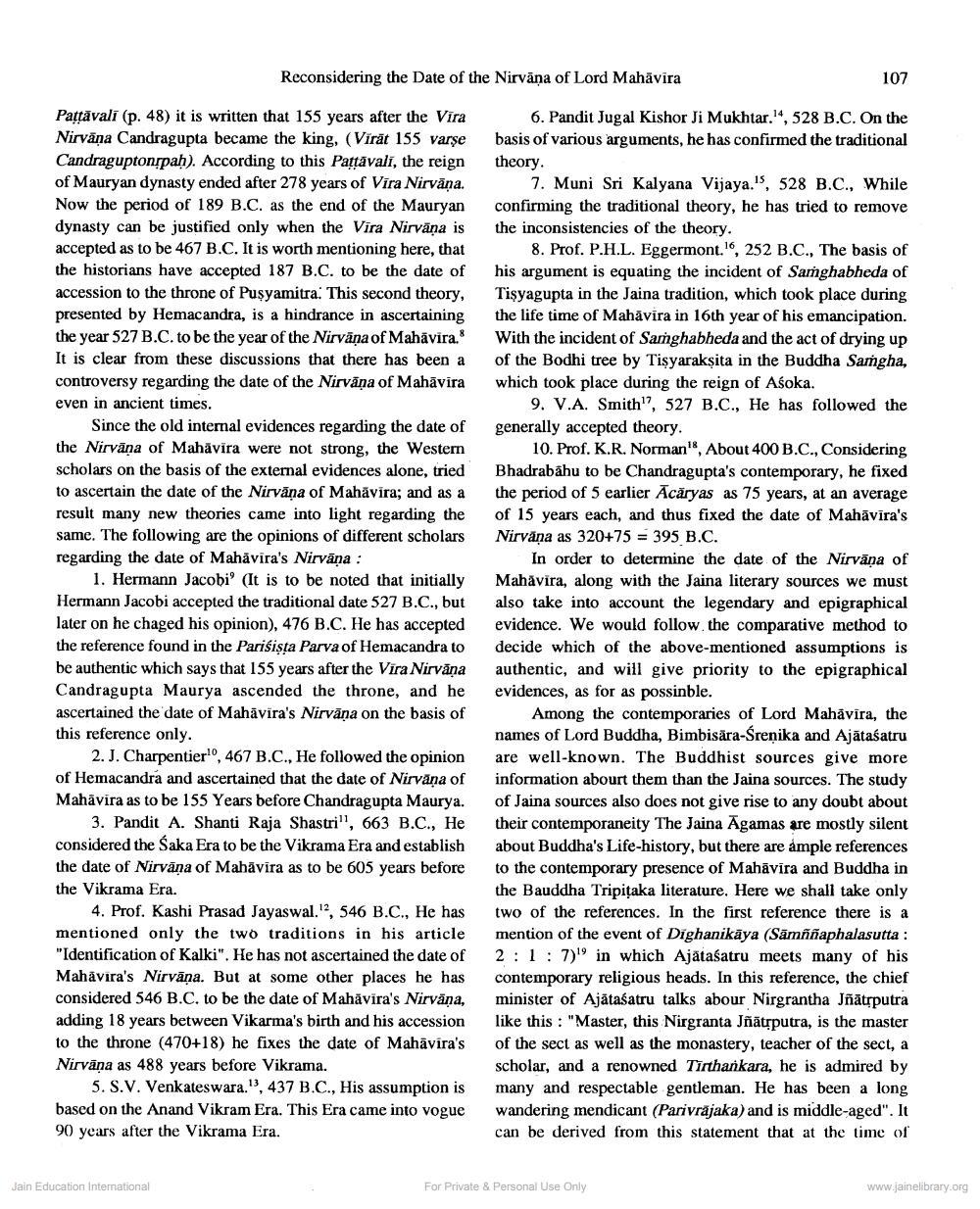Book Title: Reconsidering Date Of Nirvana Of Lord Mahavira Author(s): Sagarmal Jain Publisher: Z_Jaina_Literature_and_Philosophy_a_Critical_Approach_001936_HR.pdf View full book textPage 2
________________ Reconsidering the Date of the Nirvāṇa of Lord Mahävira 107 10 Patļāvali (p. 48) it is written that 155 years after the Vīra Nirvāṇa Candragupta became the king, (Vīrāt 155 varșe Candragupton pah). According to this Pattavali, the reign of Mauryan dynasty ended after 278 years of Vira Nirvāņa. Now the period of 189 B.C. as the end of the Mauryan dynasty can be justified only when the Vira Nirvāṇa is accepted as to be 467 B.C. It is worth mentioning here, that the historians have accepted 187 B.C. to be the date of accession to the throne of Puşyamitra. This second theory, presented by Hemacandra, is a hindrance in ascertaining the year 527 B.C. to be the year of the Nirvāņa of Mahävira. It is clear from these discussions that there has been a controversy regarding the date of the Nirvana of Mahāvira even in ancient times. Since the old internal evidences regarding the date of the Nirvana of Mahävira were not strong, the Western scholars on the basis of the external evidences alone, tried to ascertain the date of the Nirvāṇa of Mahāvīra; and as a result many new theories came into light regarding the same. The following are the opinions of different scholars regarding the date of Mahävira's Nirvāṇa : 1. Hermann Jacobi' (It is to be noted that initially Hermann Jacobi accepted the traditional date 527 B.C., but later on he chaged his opinion), 476 B.C. He has accepted the reference found in the Parisista Parva of Hemacandra to be authentic which says that 155 years after the Vira Nirvana Candragupta Maurya ascended the throne, and he ascertained the date of Mahāvira's Nirvāṇa on the basis of this reference only. 2. J. Charpentier!0,467 B.C., He followed the opinion of Hemacandra and ascertained that the date of Nirvana of Mahāvira as to be 155 Years before Chandragupta Maurya. 3. Pandit A. Shanti Raja Shastri", 663 B.C., He considered the saka Era to be the Vikrama Era and establish the date of Nirväna of Mahavira as to be 605 years before the Vikrama Era. 4. Prof. Kashi Prasad Jayaswal.', 546 B.C., He has mentioned only the two traditions in his article "Identification of Kalki". He has not ascertained the date of Mahavira's Nirvāna. But at some other places he has considered 546 B.C. to be the date of Mahavira's Nirvana, adding 18 years between Vikarma's birth and his accession to the throne (470+18) he fixes the date of Mahāvira's Nirvāṇa as 488 years before Vikrama. 5. S.V. Venkateswara.", 437 B.C., His assumption is based on the Anand Vikram Era. This Era came into vogue 90 years after the Vikrama Era. 6. Pandit Jugal Kishor Ji Mukhtar.'4, 528 B.C. On the basis of various arguments, he has confirmed the traditional theory. 7. Muni Sri Kalyana Vijaya.', 528 B.C., While confirming the traditional theory, he has tried to remove the inconsistencies of the theory. 8. Prof. P.H.L. Eggermont.6, 252 B.C., The basis of his argument is equating the incident of Samghabheda of Tişyagupta in the Jaina tradition, which took place during the life time of Mahävira in 16th year of his emancipation. With the incident of Samghabheda and the act of drying up of the Bodhi tree by Tisyarakṣita in the Buddha Saṁgha, which took place during the reign of Asoka. 9. V.A. Smith', 527 B.C., He has followed the generally accepted theory. 10. Prof. K.R. Norman", About 400 B.C., Considering Bhadrabahu to be Chandragupta's contemporary, he fixed the period of 5 earlier Acāryas as 75 years, at an average of 15 years each, and thus fixed the date of Mahāvīra's Nirvana as 320+75 = 395 B.C. In order to determine the date of the Nirvāņa of Mahavira, along with the Jaina literary sources we must also take into account the legendary and epigraphical evidence. We would follow the comparative method to decide which of the above-mentioned assumptions is authentic, and will give priority to the epigraphical evidences, as for as possinble. Among the contemporaries of Lord Mahāvīra, the names of Lord Buddha, Bimbisāra-Śrenika and Ajātaśatru are well-known. The Buddhist sources give more information abourt them than the Jaina sources. The study of Jaina sources also does not give rise to any doubt about their contemporaneity The Jaina Agamas are mostly silent about Buddha's Life-history, but there are ample references to the contemporary presence of Mahāvīra and Buddha in the Bauddha Tripitaka literature. Here we shall take only two of the references. In the first reference there is a mention of the event of Dighanikāya (Sāmññaphalasutta : 2:1: 7)' in which Ajätasatru meets many of his contemporary religious heads. In this reference, the chief minister of Ajātasatru talks abour Nirgrantha Jñātņputra like this: "Master, this Nirgranta Jñātīputra, is the master of the sect as well as the monastery, teacher of the sect, a scholar, and a renowned Tīrthankara, he is admired by many and respectable gentleman. He has been a long wandering mendicant (Parivrăjaka) and is middle-aged". It can be derived from this statement that at the time of Jain Education International For Private & Personal Use Only www.jainelibrary.orgPage Navigation
1 2 3 4 5 6 7 8 9
